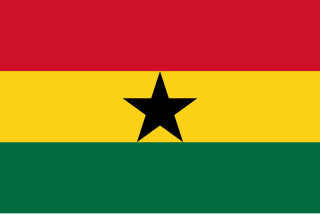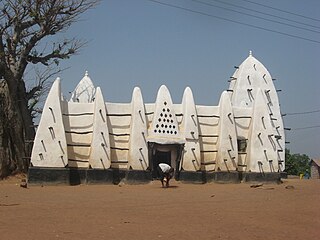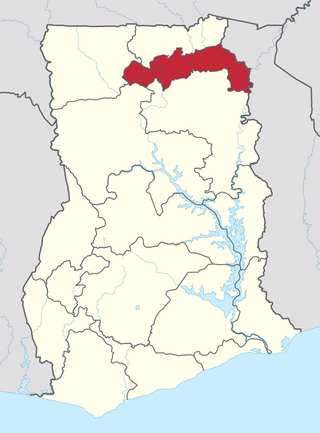Related Research Articles

The Gur languages, also known as Central Gur or Mabia, belong to the Niger–Congo languages. They are spoken in the Sahelian and savanna regions of West Africa, namely: in most areas of Burkina Faso, and in south-central Mali, northeastern Ivory Coast, the northern halves of Ghana and Togo, northwestern Benin, and southwestern Niger. A few Gur languages are spoken in Nigeria. Additionally, a single Gur language, Baatonum, is spoken in Benin and in the extreme northwest of Nigeria. Three other single Gur languages, the Tusya, Vyemo and Tiefo languages, are spoken in Burkina Faso. Another unclassified Gur language, Miyobe, is spoken in Benin and Togo. In addition, Kulango, Loma and Lorhon, are spoken in Ghana, Ivory Coast and Burkina Faso. Additionally, a few Mossi speakers are in Senegal, and speakers of the Dagaare language are also found in Cameroon. The Samu languages of Burkina Faso are Gur languages.

Ghana is a country of 28.21 million people and many native groups, such as:
The Dagombas are a Gur ethnic group of northern Ghana, numbering more than 2.3 million people. They inhabit the Northern Region of Ghana in the sparse savanna region below the sahelian belt, known as the Sudan. They speak the Dagbani language which belongs to the Mole-Dagbani sub-group of the Gur languages. There are around 1 to 2 million speakers of Dagbani. The Dagomba are historically related to the Mossi people. The Mohi/Mossi now have their homeland in central present-day Burkina Faso. The homeland of the Dagomba is called Dagbon and covers about 20,000 km2 in area.
Kusasi is a Gur language spoken primarily in northern Ghana, and Burkina Faso. It is spoken by over 150,000 people and takes its name from the Kusasi people. There are also some Kusasi in Togo. Kusaal is closely related to Mampruli, the language of the Mamprussi, who live to the south, and to Dagbani. There is a major dialect division between Agole, to the east of the Volta river, and Toende, to the West. Agole has more speakers, and the only large town of the district, Bawku, is in Agole. The New Testament translation is in the Agole dialect.

West Mamprusi Municipal Assembly is one of the six districts in North East Region, Ghana. Originally created as an ordinary district assembly in 1988 when it was known as West Mamprusi District, which was created from the former Mamprusi District Council, until the western part of the district was split off on 28 June 2012 to create Mamprugu-Moagduri District; thus the remaining part has been retained as West Mamprusi District. However, on 15 March 2018, it was elevated to municipal district assembly status to become West Mamprusi Municipal District. The municipality is located in the western part of North East Region and has Walewale as its capital town. Other settlements within the municipal assembly include Wulugu.

Ghana is a multilingual country in which about eighty languages are spoken. Of these, English, which was inherited from the colonial era, is the official language and lingua franca. Of the languages indigenous to Ghana, Akan is the most widely spoken.
The Gurunsi, or Grunshi, are a set of related ethnic groups inhabiting northern Ghana and south and central Burkina Faso.
Sisaala (Sissala) is a Gur language cluster spoken in northern Ghana near the town of Tumu and in the neighbouring republic of Burkina Faso. Western Sisaala is intermediate between Sisaali and Tumulung Sisaala.

The Bobo are a Mande ethnic group living primarily in Burkina Faso, with some living north in Mali. Bobo is also a shortened name of the second-largest city in Burkina Faso, Bobo-Dioulasso.
The Oti–Volta languages form a subgroup of the Gur languages, comprising about 30 languages of northern Ghana, Benin, and Burkina Faso spoken by twelve million people. The most populous language is Mooré, the national language of Burkina Faso, spoken by over 55% of Burkina Faso’s 20 million population and an additional 1 million in neighboring countries such as Ghana, Ivory Coast, Niger, and Mali.
Mamprusis are an ethnic group in northern Ghana and Togo. Estimates are that there are about 200,000 Mamprusis living in the Northern Regions of Ghana as of 2013, They speak Mampruli, one of the Gur languages. In Ghana, the Mamprusis live mainly in Nalerigu, Gambaga, Walewale, and their surrounding towns and villages in the North East Region. Their origin is in the Upper East Region, principally, Bawku, and they also inhabit parts of the Upper West Region, too.
The Chakosi are an Akan people who trace their origin to an area in the Ivory Coast in a place they call Anou or Ano. Thus, they refer to themselves and their language as Anufo "people of Anu". They inhabit three countries: Ghana, Benin and Togo. As of 2003 they had a combined population of 137,600. Orale narrations had it that they were in Ghana and Togo not later than 18th century and they were warriors in nature and fought a couple of battles including the ones they helped the Gonja people and the Mamprusi in building the Mamprusi Kingdom. They have names like Amoin, Akisie (Agishie), Kouasi, Adjoah, Amlan (Amanna) Ouwe, Yao, Koffi, Afoueh, N'gisah all depicting names of the days Mueneh (Sunday), Cishe (Monday), Djore (Tuesday), Mana (Wednesday), Ohue (Thursday), Ya (Friday) and Fue (Saturday) Kwa Chakosi speak the Akan dialect Chakosi language.

The Kassena people are an ethnic group located along the northern Ghana and Burkina Faso border. They speak the Kasem language. Their king lives in the town of Tiébélé. The Kasenna are closely related to the people of Nankanni and were brought together to form the Kassena-Nankana administrative district in 1936. As of 2008 the (Kassena-Nankana) area comprises two districts: Kassena Nankana West and Kassena Nankana East.
The Mamprusi language is a Gur language spoken in northern Ghana, Northern Togo, Burkina Faso, Ivory Coast and Mali by the Mamprusi people. It is partially mutually intelligible with Dagbani. The Mamprusi language is spoken in a broad belt across the northern parts of the Northern Region of Ghana, stretching west to east from Yizeesi to Nakpanduri and centred on the towns of Gambaga, Nalerigu and Walewale.
Vagla is a Gurunsi (Gur) language of Ghana with about 14,000 speakers. It is spoken in a number of communities around the western area of Northern Region, Ghana. Such communities includes: Bole, Sawla, Tuna, Soma, Gentilpe, and Nakwabi. The people who speak this language are known as Vaglas, one of the indigenous tribes around that part of the Northern Region, which were brought under the Gonja local administration system "Gonjaland" by British Colonial Rulers under their Centralised System of Governance.

Walewale is a town and the capital of Mamprusi West Municipal in the Northeast Region of Ghana. It lies on the main road from Bolgatanga to Tamale, at the junction of the road west to Nalerigu, the capital of the newly created Northeast Region. It was founded by the Mamprusis. The language spoken by the people of Walewale is largely Mampruli, which is followed by kassim. The Dominant religion is Islam but a lot of churches are emerging in recent times. Walewale prides itself of four standard banks which are; Ghana Commercial Bank, Agricultural Development Bank, Bangmarigu Community Bank and GN Bank which is currently defunct. The town has about ten standard guest houses with two five star hotels located along the main road leading to Bolgatanga, the Upper East Regional capital. There are six fuel filling stations in the community namely; Total Fuel Station, Nasona Fuel Station, Zen Fuel Station, Goil Fuel Station and Petrosol, It also has a Gas filling station located along the Nalerigu road.
Builsa is a town in the Builsa District of the Upper East Region of Ghana. The capital of Bulsa North District is Sandema, of Bulsa South District Fumbisi; other villages/towns are Wiaga, Fumbisi, Kanjaga, Gbedema, Siniensi, Kadema and Chuchuliga.

Burkina Faso is a small, landlocked country north of Ghana and south of Mali and Niger. Economically, it is one of the four or five poorest countries in the world. Culturally, it is extremely rich. In part this is because so few people from Burkina have become Muslim or Christian. Many of the ancient artistic traditions for which Africa is so well known have been preserved in Burkina Faso because so many people continue to honor the ancestral spirits, and the spirits of nature. In great part they honor the spirits through the use of masks and carved figures. Many of the countries to the north of Burkina Faso had become predominantly Muslim, while many of the countries to the south of Burkina Faso are heavily Christian. In contrast many of the people of Burkina Faso continue to offer prayers and sacrifices to the spirits of nature and to the spirits of their ancestors. The result is that they continue to use the sorts of art that we see in museums in Europe and America.

The Savannah Region is one of the newest regions of Ghana and yet the largest region in the country. The creation of the Region follows presentation of a petition by the Gonja Traditional Council, led by the Yagbonwura Tumtumba Boresa Jakpa I. Upon receiving favourable responses from all stakeholders in the Northern Region, the Brobbey Commission, a referendum was conducted on the 27th December 2018. The result was a resounding yes of 99.7%. The President of the Republic of Ghana signed and presented the Constitutional Instrument (CI) 115 to the Yagbonwura in the Jubilee House, Accra on 12 February 2019. The launch was well attended by sons and daughters of Gonjaland including all current and past Mps, MDCEs and all appointees with Gonjaland descent. Damongo was declared the capital of the new Savannah Region. It is located in the north of the country. The Savannah Region is divided into 7 districts; Bole, Central Gonja, North Gonja, East Gonja, Sawla/Tuna/Kalba, West Gonja, North East Gonja and 7 Constituencies; Bole/Bamboi, Damongo, Daboya/Mankarigu, Salaga North, Salaga South, Sawla/Tuna/Kalba and Yapei/Kusawgu. The capital of Bole district is Bole; East Gonja municipal is Salaga; West Gonja district is Damango; Sawla Tuna Kalba district is Salwa; Central Gonja is Buipe; North Gonja is Daboya; and North East Gonja is Kpalbe

The North East Region is one of the sixteen regions of Ghana. It is located in the north of the country and was created in December 2018 after a referendum was voted upon to break it off of the Northern region. The region's capital is Nalerigu.
References
- ↑ Tampusi at Ethnologue (18th ed., 2015) (subscription required)